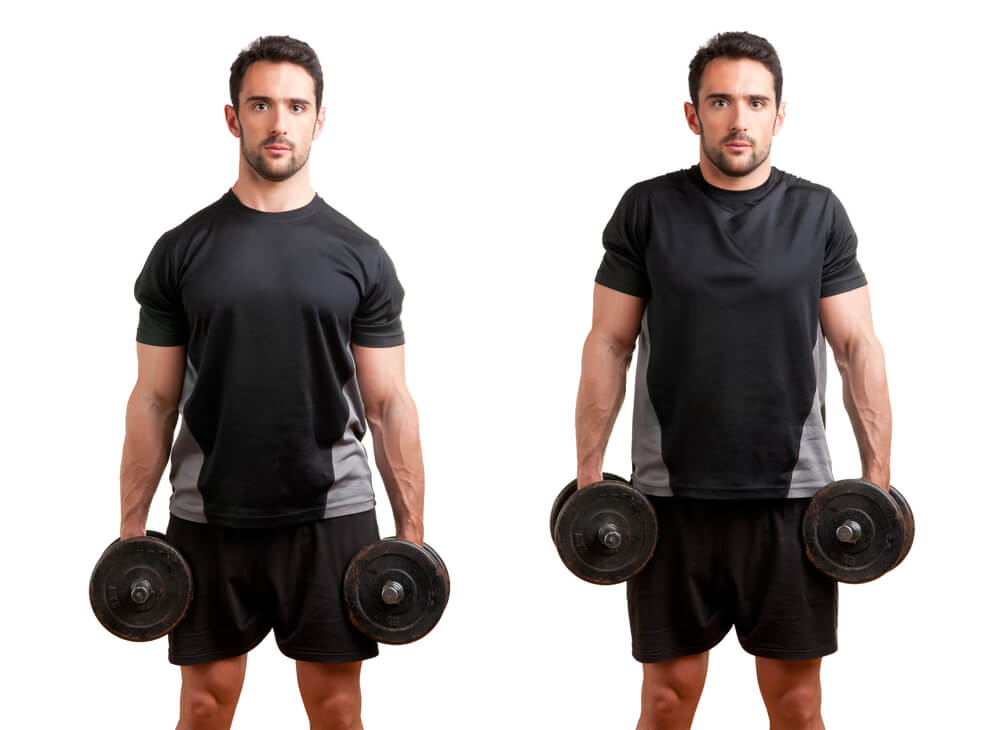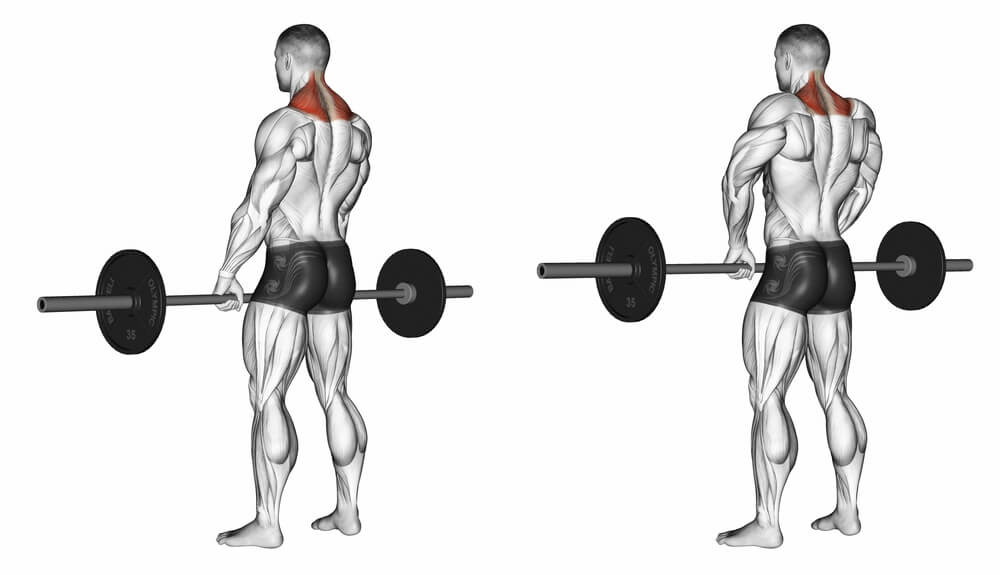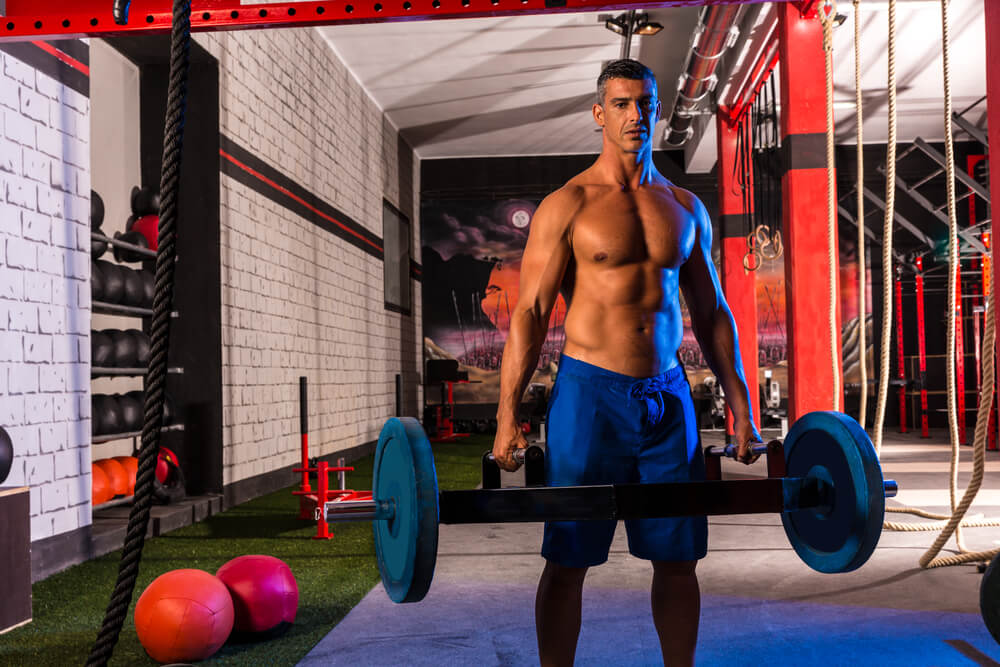The shoulder shrug often referred to as just a “shrug” is one of the more commonly overlooked lifts.However, it is an easy, quick lift you can add to any routine.
It also can aid in the performance of most other upper body lifts along the way. With several variations available to help you target different aspects of your neck, shoulders and upper back, the shrug is a lift you need to consider adding to your workout.
What Muscles Do Shrugs Work?
The shrug directly targets the upper trapezius muscle.
The trapezius muscle group forms a triangle, running along the spine beginning in the middle of your back up to the base of the skull. It then curves over your neck to the shoulder bone and around the shoulder blade.
The trapezius is broken down into three different parts.
There is the Inferior fibers, which makes up the area covering your upper back. The Middle fibers run from shoulder bone to shoulder bone and the Superior fibers connect right above the Middle fibers, running along the top of your collarbone and to the base of your skull.
While the shrug will work all of these areas of the trapezius, you’ll primarily experience the most strength conditioning in the Superior fibers (although the different shrug exercises you add to your workout can vary where and how it affects your muscle group).
How To Do The Shoulder Shrug
The shrug is a simple move to perform.
Stand straight with your legs slightly more than shoulder length apart and your hands down right around shoulder length. Holding the weight in both hands you will raise your shoulders up as high as possible as if you are stretching your shoulders out. Hold at the peak of the shrug and then lower your shoulders back down. Try not to simply drop your shoulders down but to slowly lower the shoulders as this will help strengthen your trapezius further.
Some lifters prefer to simply go up and down with the move while others will perform a standard shrug, where your shoulders rotate around.
What Kind of Equipment Should You Use For Shrugs?
The barbell is a common piece of equipment used to perform the shrug.
Barbell Shoulder Shrugs
While holding the barbell in front of you, lift your shoulders up, hold at the peak and lower the shoulders back down slowly. When using a barbell be mindful of any tilting one way or the other. Any tilting means one side is working harder than the other. A major benefit of using a barbell is you increase the amount of work stabilizer muscles receive.
These are muscle groups machines and stationary devices will not work. Instead of a barbell, a trap bar can work as well. With a trap bar, you stand inside of the rectangular bar construction.
The name of the bar itself is named after the trapezius muscles, for which the shrug trains. Using the trap bar can be helpful if you suffer from knee pain. This reduces the amount of weight located directly in front of your body and puts it to the side instead.
If the bar is available, you should experiment with it to see what bar method you like the best.
Dumbell Shoulder Shrug
A dumbbell workout is great because you can do it in smaller areas (such as your home) and it probably is the most beneficial.
By isolating each arm with its own weight, it forces each arm to do the same level of lifting. The one downside with a barbell is as it is a single bar, one shoulder may perform more of the lift. Kettlebells can also be used instead of a dumbbell. It is best to use a kettlebell for each arm. You may even find you like the feel of the kettlebell more than a dumbell because all of the weight is directly on your hand, instead of the wider dumbbell.
It’s a personal preference, but realistically the two are very similar in functionality for this exercise.
Smith Machine For Shoulder Shrugs
The Smith Machine is an available option, but the downside to a Smith Machine is the barbell is locked into place. This prevents the stabilizer muscles from receiving any kind of work as the small muscles are not activated during the lift.
Resistance Bands For Shrugs
Resistance bands are another option available to you for this kind of lift. Generally, you won’t be able to have the kind of extreme weight with resistance bands, so if you’re looking to max out this area of your body you probably should skip the resistance bands.
However, in a pinch, resistance bands are suitable (especially if you travel a good deal and don’t have access to a full gym).
Shoulder Shrug Variations
There are different ways to perform the shrug lift.
Some of these methods are designed to reduce cheating and direct more of the weight to the traps. Other variations help target different areas of the muscle group for bigger gains. If you’re looking to really super size your traps than considering bringing in all of them into your workout routine.
If you just want one to simply make sure the muscle group isn’t forgotten about than experiment with the lifts and see what works best for you.
Seated Shrug
While performing a lift your body often cheats and you may not even know about it.
How does your body cheat during a shrug?
If you are lifting especially heavyweights your hips may try to get into the action. This reduces the amount of tension placed directly on your shoulders and traps. In order to remove any and all cheating, simply sit down for the lift. You can sit on the edge of a bench or even go down onto your knees (just make sure there is a mat under your knees).
This reduces all of the cheating potential and places all of the weight firmly around your shoulders.
Haney Shrug
Think of this like a barbell shrug, only reversed.
You can place a barbell on a squat rack or a Smith Machine.
However, instead of having the bar in front of you, it will be behind you. This places more weight directly on the middle section of the traps. When first starting out, it is ideal to go with the Smith Machine until you become a bit more accustomed to the slight shift in movement. You may also want, to begin with, a lower weight amount.
Overhead Shrug
Typically, you are going to use heavy weights when performing a shrug.
As you’re using a single muscle group and you’re not pushing the weights above your head it doesn’t put as much strain on other areas of the body.
However, when constantly lifting heavy weights, you may eventually find your shoulders can begin rotating downward. Also known as depressed shoulders, if your shoulders remain in this position it can lead to other shoulder issues, such as rotator cuff. In order to help even out this situation and prevent a depressed shoulder, you should perform an overhead shrug as well. With an overhead shrug, you’ll want to use light weights.
Using dumbbells or a barbell, push the bar over your head as if you are performing a military press on a machine.
At the top, hold the bar (maintaining just a slight bend in the arms in order to prevent the joints from locking up). In the top position, squeeze everything from your glute muscles and tighten your shoulder blades. This will force the shoulder blades up. Slowly lower the bar back down and perform 10 to 12 reps. The overhead shrug isn’t necessarily designed to strengthen the traps. It’s more there to prevent possible injuries from depressing your shoulders (Muscle and Fitness, 2014).
Farmer’s Walk Shrug
This is a nice way to work more than just your traps at once.
If you are short on time or just don’t want to spend hours at the gym, one of the best ways is to perform moves that hit multiple areas on your body. The farmer’s walk shrug is one such option. In order to start the workout routine, you’ll need dumbbells.
Hold the heavy weight on each side of your body but make sure you maintain excellent posture (neck straight in the air and chest up, there shouldn’t be any learning). Now, walk 10 steps, stop and perform 10 shrugs. Walking with the heavy weight will work your lower body, and yet holding the heavyweight will put extra straight on your shoulders prior to performing the shrug.
If you do this six to 10 times each, you’ll really have a great burn of a workout.
When to Avoid a Shrug
The shrug is an excellent workout dedicated to improve the size of your traps and help strengthen your shoulders.
By improving the strength of your traps you’ll also go a long way in improving your performance in other lifts, ranging everywhere from your bench press to pull ups. However, there are times you should avoid performing a shrug. It doesn’t open you up to as many injuries as other lifts as you don’t put a ton of pressure on specific joints through extensive movements.
However, if you have suffered another injury recently, you’ll want to stop performing the shrugs for the time being.
If you recently injured your wrist, you’ll want to avoid performing a shrug. The wrist is the only real joint where weight is pulling down on it. This means almost all of the weight of the shrug lift is placed right on the wrist. A shrug lift with an injured wrist is especially painful and opens you up for additional injuries (Healthy Living, 2017).
Additionally, if you’ve injured your shoulders in any way, avoid the shrug. You’ll want to hold off on the shrug until your doctor gives you the all-clear.
What the Shrug Can Replace
Outside of the wrists, the shrug doesn’t put a ton of pressure on joints, which reduces the chance of injury.
One list you may want to consider replacing with the shrug is the upright row. The upright row works the traps, biceps, and chest. It also puts a considerable amount of pressure on the elbow and shoulder joints. If you feel any pain in your upper body while performing an upright row you’ll want to stop the lift.
The shrug is an excellent replacement option and it should cut down any level of discomfort you typically experience when at the gym lifting.
Typical Shoulder Shrug Workout
Typically, when you perform a shrug lift you’ll want to go with heavy weights.
As there is very little joint movement you won’t put any real pressure on these areas of your body. It also makes it possible to lift more without injury. With correct posture, perform the shrug 10 times, making sure to take your time as the shoulders decompress downward. The second time through if you performed the previous shrug 10 times up the weight. If you were not able to hit 10 keep the weight as is.
As is the case with any other lift or exercise, if you feel any level of discomfort or pain, make sure to stop the exercise immediately.
Conclusion
The shrug is a smaller lift that doesn’t require any real equipment outside of dumbbells.
It can be quickly added into any routine without taking up much time and, best of all, it hits a spot on your body you probably miss. The traps is a major muscle group that assists with the performance of nearly all other upper body movements.
By increasing the strength of your traps you’ll increase the strength of your chest, shoulders, and biceps. While a simple lift, it needs to be done correctly in order to avoid possible injuries and to make sure all of the lift weight is directed towards the upper shoulders and neck (and not on the knees and hips).
So for a true upper body workout, always make sure to add in the shrug whenever possible.
-Terry Asher
Terry Asher
Latest posts by Terry Asher (see all)
- Better Family – Product Review Liquid Daily 2 oz - Dec 16, 2024
- Post-Workout Recovery: The Key to Optimal Performance - Nov 25, 2024
- Pre-Workout Supplements – Everything You Need To Know - Nov 18, 2024














Really great information about best shrugs under 1000 in India .